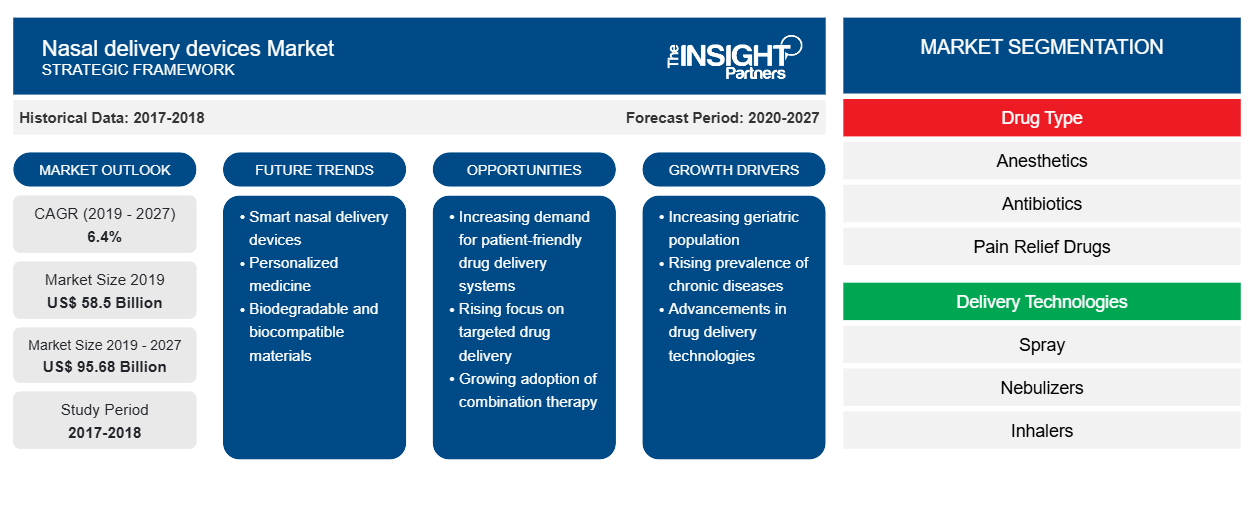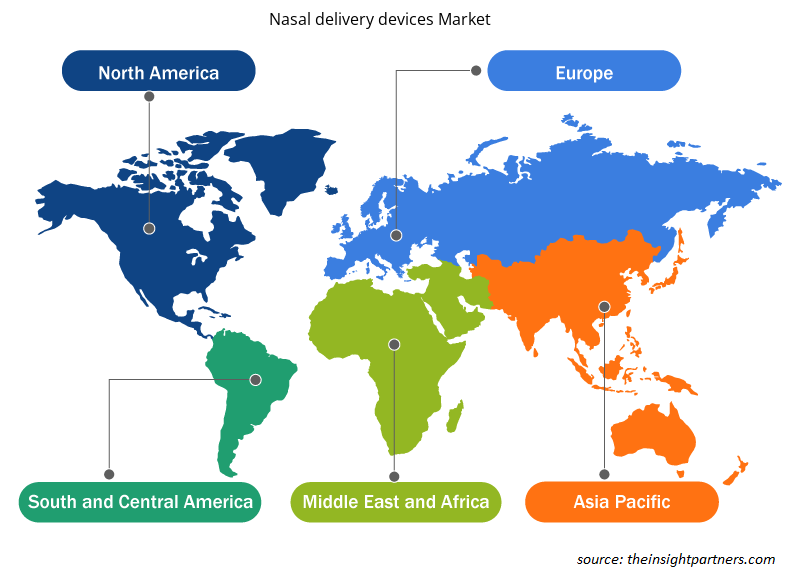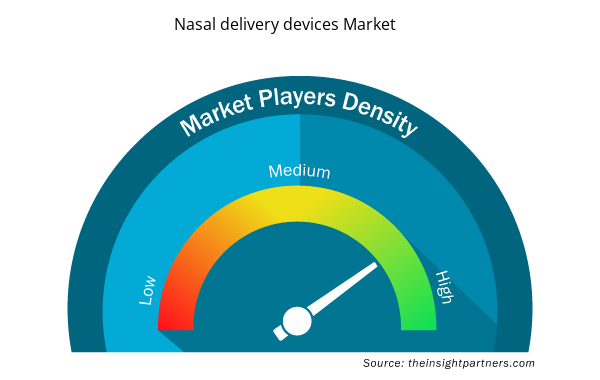The nasal delivery devices market is expected to reach US$ 95,676.62 million by 2027 from US$ 58,502.18 million in 2019. The market is estimated to grow with a CAGR of 6.4% from 2020 to 2027.
Nasal drug delivery is one of the most preferred drug delivery routes among patients as well as healthcare providers. This can majorly be attributed to the noninvasive nature of this route of delivery and greater drug absorbability through the nasal route. In addition, the nasal route offers a less hostile environment for drugs compared to the gastrointestinal route, thereby enabling better absorption of the drug. The easy administration of these drugs plays a crucial role in improving the compliance to drug therapies among patients, which in turn drives patient outcomes. Considering these factors, the preference for nasal drug delivery is increasing among patients as well as healthcare providers. Being highly vascular, nasal cavity enhances the drug absorption resulting in rapid action. The World Health Organization (WHO) has specific guidelines for manufacturers, which outlines all necessary requirements for the adoption of new nasal delivery devices with a single-use delivery system. Thus, nasal drug delivery, unlike other routes of drug delivery, does not require stringent sterile methods for administering drugs into the body. Thus, the high preference for nasal drug delivery among patients and health care providers, due to the growing awareness regarding its benefits, is driving the market growth.
Customize This Report To Suit Your Requirement
You will get customization on any report - free of charge - including parts of this report, or country-level analysis, Excel Data pack, as well as avail great offers and discounts for start-ups & universities
Nasal delivery devices Market: Strategic Insights

- Get Top Key Market Trends of this report.This FREE sample will include data analysis, ranging from market trends to estimates and forecasts.
Customize This Report To Suit Your Requirement
You will get customization on any report - free of charge - including parts of this report, or country-level analysis, Excel Data pack, as well as avail great offers and discounts for start-ups & universities
Nasal delivery devices Market: Strategic Insights

- Get Top Key Market Trends of this report.This FREE sample will include data analysis, ranging from market trends to estimates and forecasts.
Market Insights
Growing Prevalence of Respiratory and CNS Diseases
The initial proof-of-concept studies using novel nasal drug delivery devices showed promising results in the treatment of respiratory diseases, neurological disorders, and others. Drug delivery devices play an essential role in ensuring the delivery of entire drug to the target site in the nasal cavity. In the last few decades, several innovative drug delivery approaches have been introduced that might overcome the challenges involved in crossing the blood-brain barrier (BBB). Several scientific studies support the speculation that the delivery of drugs through the nasal route may allow higher concentrations of drugs to cross the BBB. The, rising incidence of neurological disorders would increase the demand for nasal delivery devices. According to the American Society of Clinical Oncology (ASCO), in 2020, ~3,540 brain and other CNS tumors have been diagnosed in children belonging to the age group of 0–14 years, in the US. The report also stated that the brain and other CNS tumors are the second most common cancers among children, accounting for ~26% of cancer cases in children with <15 years of age.
Respiratory conditions such as acute lower respiratory tract infections, tuberculosis, chronic obstructive pulmonary disease (COPD—a disease spectrum that includes bronchitis and emphysema), asthma, and lung cancer are among the most common causes of severe illnesses and deaths globally. Growing urbanization and pollution, unhealthy lifestyle and habits, and high tobacco smoking prevalence are among the factors leading to the surge in respiratory and cardiovascular disease cases. The respiratory could cause acute respiratory failure, treatment of which requires nasal drug delivery for continuous support. According to the Global Asthma Report 2018, published by Global Asthma Network, ~330 million people in the world are asthmatic. In addition, as per the estimates of Global Burden of Disease, a special research project by the Institute for Health Metrics and Evaluation, in 2016, ~420,000 died due to asthma. According to a study published in the US National Library of Medicine National Institutes of Health in 2018, the prevalence of asthma is consistently high in Korea, especially among female and elderly populations. Moreover, according to the Global Burden of Disease Study report, prevalence of COPD cases was 251 million in 2016. More than 90% of COPD deaths occur in low and middle-income countries (LMICs), and the disease is likely to become a leading cause of death in the world in the next 15 years.
Thus, the growing prevalence of respiratory diseases, neurological disorders, and other chronic diseases is boosting the demand for nasal delivery devices for effective drug delivery at the target sites.
Drug Type Insights
Based on drug type, the nasal delivery devices market is segmented into anesthetics, antibiotics, pain relief drugs, calcium supplements, vasoconstrictors, antihistamines, and others. In 2019, the antihistamines segment accounted for the largest share of the market. Growth of this segment is attributed to increase in allergic rhinitis.
Delivery Technologies Insights
Based on delivery technologies, the global nasal delivery devices market is segmented into spray, nebulizers, inhalers, and others. In 2019, the inhalers segment held a major share of the market and is anticipated to register the highest CAGR in the market during the forecast period.
End User Insights
Based on end user, the global nasal delivery devices market is segmented into home care settings, hospitals, and clinics. In 2019, the home care settings segment held a major share of the market and is anticipated to register the highest CAGR in the market during the forecast period.
Product launches and approvals are the commonly adopted strategies by companies to expand their global footprints and product portfolios to meet the growing consumer demand. The nasal delivery devices market players adopt the collaborations strategy to enlarge customer base worldwide, which also permits them to maintain their brand name globally.
Nasal delivery devices Market Regional Insights
Nasal delivery devices Market Regional Insights
The regional trends and factors influencing the Nasal delivery devices Market throughout the forecast period have been thoroughly explained by the analysts at Insight Partners. This section also discusses Nasal delivery devices Market segments and geography across North America, Europe, Asia Pacific, Middle East and Africa, and South and Central America.

- Get the Regional Specific Data for Nasal delivery devices Market
Nasal delivery devices Market Report Scope
| Report Attribute | Details |
|---|---|
| Market size in 2019 | US$ 58.5 Billion |
| Market Size by 2027 | US$ 95.68 Billion |
| Global CAGR (2019 - 2027) | 6.4% |
| Historical Data | 2017-2018 |
| Forecast period | 2020-2027 |
| Segments Covered |
By Drug Type
|
| Regions and Countries Covered | North America
|
| Market leaders and key company profiles |
Nasal delivery devices Market Players Density: Understanding Its Impact on Business Dynamics
The Nasal delivery devices Market market is growing rapidly, driven by increasing end-user demand due to factors such as evolving consumer preferences, technological advancements, and greater awareness of the product's benefits. As demand rises, businesses are expanding their offerings, innovating to meet consumer needs, and capitalizing on emerging trends, which further fuels market growth.
Market players density refers to the distribution of firms or companies operating within a particular market or industry. It indicates how many competitors (market players) are present in a given market space relative to its size or total market value.
Major Companies operating in the Nasal delivery devices Market are:
- GlaxoSmithKline plc.
- AstraZeneca
- Pfizer Inc.
- BD
- Sanofi
Disclaimer: The companies listed above are not ranked in any particular order.

- Get the Nasal delivery devices Market top key players overview
Nasal Delivery Devices Market – By Drug Type
- Anaesthetics
- Antibiotics
- Pain Relief Drugs
- Calcium Supplements
- Vasoconstrictors
- Antihistamines
- Others
Nasal Delivery Devices Market – By Delivery Technologies
- Spray
- Nebulizers
- Inhalers
- Others
Nasal Delivery Devices Market – By End User
- Home Care Settings
- Hospitals
- Clinics
Nasal Delivery Devices Market – by Geography
- North America
- US
- Canada
- Mexico
- Europe
- France
- Germany
- Italy
- UK
- Spain
- Rest of Europe
- Asia Pacific (APAC)
- China
- India
- South Korea
- Japan
- Australia
- Rest of Asia Pacific
- Middle East & Africa (MEA)
- South Africa
- Saudi Arabia
- UAE
- Rest of Middle East & Africa
- South and Central America
- Brazil
- Argentina
- Rest of South America
Company Profiles
- GlaxoSmithKline plc.
- AstraZeneca
- Pfizer Inc
- BD
- Sanofi
- Merck & Co., Inc.
- Cadila Pharmaceuticals Ltd.
- Novartis AG
- Dr. Reddy's Laboratories
- Neurelis, Inc
- Historical Analysis (2 Years), Base Year, Forecast (7 Years) with CAGR
- PEST and SWOT Analysis
- Market Size Value / Volume - Global, Regional, Country
- Industry and Competitive Landscape
- Excel Dataset


- Pharmacovigilance and Drug Safety Software Market
- Carbon Fiber Market
- 3D Audio Market
- Passport Reader Market
- Environmental Consulting Service Market
- Digital Language Learning Market
- Data Annotation Tools Market
- Real-Time Location Systems Market
- Visualization and 3D Rendering Software Market
- Unit Heater Market

Report Coverage
Revenue forecast, Company Analysis, Industry landscape, Growth factors, and Trends

Segment Covered
Drug Type ; Delivery Technologies ; End User , and Geography

Regional Scope
North America, Europe, Asia Pacific, Middle East & Africa, South & Central America

Country Scope
Argentina, Australia, Brazil, Canada, China, France, Germany, India, Italy, Japan, Mexico, Saudi Arabia, South Africa, South Korea, Spain, United Arab Emirates, United Kingdom, United States
Frequently Asked Questions
The nasal delivery devices market majorly consists of the players such as GlaxoSmithKline plc.,AstraZeneca, Pfizer Inc., BD, Sanofi, Merck & Co., Inc., Cadila Pharmaceuticals Ltd., Novartis AG, Dr. Reddy's Laboratories, and Neurelis. amongst others.
The factors that are driving growth of the market are growing prevalence of respiratory and cns diseases and increasing preference and awareness of intranasal drug delivery among patients.Moreover, strategic activities by the manufacturersare offering lucrative opportunities for the growth of the market.
Nasal drug delivery is one of the efficient route of drug administration. It offers needle-free drug delivery, optimal route for brain-targeted therapies, and superior bioavailability. Nasal route of administration is preferred in several disease indications such as Parkinson’s disease, prostate cancer, migraine, and influenza amongst others. Moreover, nasal route is also suitable for the treatment of drug addiction as well as for sedation.
Trends and growth analysis reports related to Life Sciences : READ MORE..
The List of Companies - Nasal delivery devices Market
- GlaxoSmithKline plc.
- AstraZeneca
- Pfizer Inc.
- BD
- Sanofi
- Merck & Co., Inc.
- Cadila Pharmaceuticals Ltd.
- Novartis AG
- Dr. Reddy's Laboratories
- Neurelis, Inc.

 Get Free Sample For
Get Free Sample For